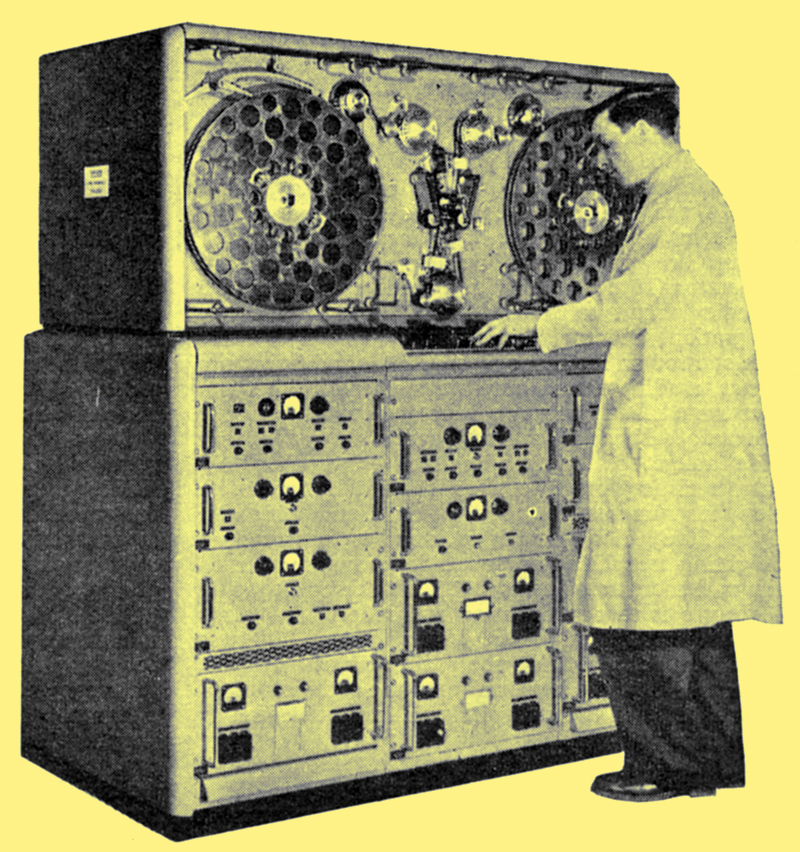|

Standard grade 0.5 inch magnetic tape running at 200 inches per second is used in the BBCs new Vision Electronic Recording Apparatus (called VERA ) which television viewers have recently seen in operation. The method of recording is the straightforward longitudinal one, and 15 minutes of programme can be accommodated in a 20.5 inch spool of tape. A complete video recording channel consists of two of the machines controlled from a central desk.
Actually the method of recording is not quite straight forward, in that the incoming 3 MHz video signal is split into two frequency bands of 0-100kHz and 100kHz-3MHz the low band is used to frequency modulate a 1 MHz carrier signal, and it is the frequency deviations of this signal which are carried in the other track. The modulation is only in one direction, so that 1 MHz corresponds to minimum video amplitude at the bottom of the sync waveform and 400kHz to peak white.
This FM carrier system has been adopted mainly to avoid the effects of tape imperfections and spurious amplitude modulation, which experience has shown to be more noticeable in the low- frequency components of the television picture (for example, as fluctuations in large-area brightness). It also avoids the fall-off in low-frequency response which occurs during playback as a result of the slower rate-of-change of flux at low frequencies and the increase of wavelength at the high tape speed. A limiter is used in the FM channel just as in FM receiving technique. Unwanted amplitude variations also occur in the 100 kHz-3 MHz video band but these do not noticeably degrade the picture.
The television sound signal is recorded in a third track, and the opportunity has been taken of again using an FM carrier system, which simplifies the problem of recording and reproducing the low frequencies at the high tape speed.
Extreme precautions have been taken to maintain constant tape speed past the recording and reproducing heads, since very small fluctuations can cause noticeable horizontal displacements in the reproduced picture similar to line tearing. The initial tape drive is on, the spools themselves, with automatic adjustment for the amount of tape they carry. The final drive is from a capstan which operates inside a loop of tape, providing drive for both oppositely moving sides of the loop at once. This system effectively isolates the tape loop from speed fluctuations in the spool drive. During recording the capstan drive is synchronized with the 50 Hz mains. On playback its speed is controlled by a servo system which compares the reproduced sync pulses with the station sync pulses and applies appropriate correction signals. A tape speed accuracy of 0.04% is said to be obtained.
The three-channel recording and reproducing heads, which are independent and situated in the tape loop mentioned above, use ferrite cores for efficient operation at the high frequencies. They are surfaced with Mumetal where the tape passes over them and have gap widths of the order of 2 x 10-5 inch. The gap width, of course, in conjunction with the tape speed, is the thing which determines the maximum resolution of the recording system. In terms of frequency response, the equipment is flat to 2 MHz and falls 3dB at 2.5 MHz.
For marking editing points on the tape a 30 kHz burst of signal is switched on to the sound track. This becomes audible on playing back at slow speed.
The following article is from Wikipedia.
Vision Electronic Recording Apparatus (VERA) was an early analogue recording videotape format developed from 1952 by the BBC under project manager Dr Peter Axon.
In order to record high frequencies, a tape must move rapidly with respect to the recording or playback head. The frequencies used by video signals are so high that the tape/head speed is on the order of several meters per second (tens of feet per second), an order of magnitude faster than professional analogue audio tape recording. The BBC solved the problem by using 52-centimetre (20 in) reels of magnetic tape that passed static heads at a speed of 5.08 metres per second (16.7 ft/s).
VERA was capable of recording about 15 minutes (e.g. 4,572 meters) of 405-line black-and-white video per reel, and the picture tended to wobble because the synchronizing pulses that keep the picture stable were not recorded accurately enough.
In order to cope with 625-line PAL or SECAM colour transmissions VERA would likely have required an even faster, and possibly unfeasible, tape speed.
Development began in 1952, but VERA was not perfected until 1958. It was given a live demonstration on-air in Panorama on April 14, 1958; Richard Dimbleby, seated by a clock, talked for a couple of minutes about the new method of vision recording with an instant playback, and then the tape was wound back and replayed. The picture was slightly watery, but reasonably watchable, and of course instant playback was something completely new.
However by this time it had already been rendered obsolete by the Ampex quadruplex video recording system. This used 5-centimetre (2.0 in) wide tapes running at a speed of 38 cm (15 in) per second. The rapid tape-to-head speed of quadruplex videotape was achieved by spinning the heads rapidly on a drum: the system used, with variations, on all video tape systems ever since, as well as DAT.
The BBC scrapped VERA and quickly adopted the Ampex system. It has been suggested that the BBC only continued to develop VERA as a bargaining tool, so it would be offered some of the first Ampex machines produced in unstated exchange for abandoning further work on a potential rival.
Films of VERA
In the films section are two clips of this machine. The first is from the Panarama program and the second is an interview with the chief designer, Dr Peter Axon.
|